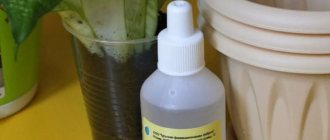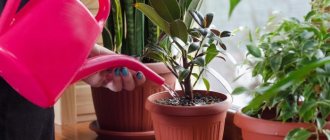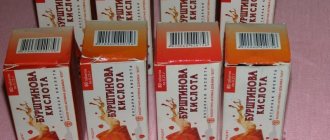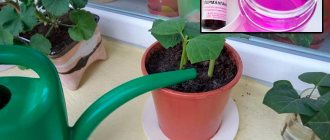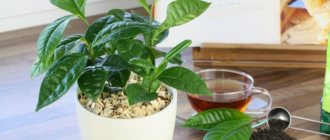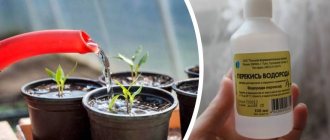Hydroponic gardeners sometimes use hydrogen peroxide to care for their plants. Spontaneous decomposition of the drug releases oxygen in the root system of plants, which promotes better development of roots and protects them from rotting. Many farmers have achieved better yields by spraying with a dilute H2O2 solution. Hydrogen peroxide can be used for plants, the use of which occurs mainly in the medical field, for disinfection, strengthening, fertilization and disease control.
The product copes well with various bacteria and is suitable for treating seeds, seedlings, and adult plants. At the correct dosage, peroxide can be introduced into the aquarium environment without removing the inhabitants to remove tenacious blue-green algae and stop rotting processes.
Why do flowers need hydrogen peroxide?
Hydrogen peroxide (H2O2) is considered an ideal option for disinfecting indoor flowers. It helps prevent the development of fungal, viral and bacterial infections in both healthy and damaged flowers.
H2O2 will also help stop the processes of rotting of the root system, disinfect and saturate the soil with oxygen, and also speed up flowering.
INTERESTING! If an indoor flower begins to fade, then hydrogen peroxide can revive it.
Protection from diseases
If the question is whether it is possible to water sick plants with peroxide, you need to understand the causes of the diseases. The drug can be used to combat certain phenomena:
- the formation of mold on the soil surface;
- the appearance of green algae and plaque on the pots;
- Root rotting as a result of waterlogging.
For processing, prepare a solution consisting of 1 liter of clean warm water and 3 tbsp. 3% peroxide. When fighting mold, add an additional 1 tsp to the composition. phosphorus liquid fertilizer, this helps strengthen the immunity of plants. If it is necessary to stop the decay processes, it is not advisable to introduce fertilizer; instead, add 1 tbsp. l. Sahara. Sick specimens need to be watered at least 2 times a week until signs of the disease disappear, but not longer than 3 weeks.
Recommendation. Green transparent pots (from orchids, spathiphyllums, ferns) are treated with undiluted preparation. It disinfects the surface and slows down the formation of new microorganisms.
For the garden and the prevention of diseases of garden crops, peroxide is used as follows:
- to prevent late blight, seedlings are treated with a weak solution (1 tablespoon H2O2 3% per 5 liters of water);
- To disinfect garden tools and greenhouses, use an undiluted product, wiping moldy areas or cleaning the surface of tools.
How to dilute hydrogen peroxide for flowers
You will not just need to make a mixture of hydrogen peroxide for watering indoor flowers. The proportions must be precisely maintained so as not to harm the flower garden. You also need to know how often to apply peroxide when growing indoor flowers.
REFERENCE! In all cases, the working solution for both processing and feeding indoor flowers will be prepared from a 3% variety of the drug. The advantage is that it can be easily found in any pharmacy. Pure H2O2 preparation, undiluted with water, is never used!
Hydrogen peroxide solution for watering flowers proportions
Now we’ll tell you exactly how to use hydrogen peroxide for watering indoor flowers. The proportions must be maintained as follows: on average 2 drops of peroxide per 1 liter of water.
How to dilute peroxide for spraying indoor plants, proportions
To prepare a spray product, pour 2-3 tablespoons (30-50 ml) of H2O2 into 1 liter of filtered and definitely settled water at a temperature of 20-24 degrees (that is, in a ratio of approximately 1:25).
Treatment with this mixture is carried out as necessary for each type of flower crop individually (suitable for daily treatment).
Flower growers claim that a positive effect can be observed after 10-12 days (growth of green mass, brighter color of leaves and flowers).
There is also a known recipe for a treatment product, the action of which is aimed at preventing the appearance of pests on indoor flowers.
Mix 20 ml of aseptolin or alcohol, 50 ml of H2O2 in 900 ml of water, and also add a very small drop of dishwashing detergent. It is recommended to carry out the treatment every day so that the prepared mixture gets onto all areas of the leaf blades and stems.
If you plan to use this treatment to cope with the development of diseases or parasitic insects, you will need to pour 2 tablespoons of peroxide (30 ml) and 2 drops of iodine into 1 liter of water. Spray every day for 7 days.
How to Use Hydrogen Peroxide to Soak Flower Seeds
Soaking seeds in an aqueous solution with the addition of H2O2 helps to increase the degree of germination and also accelerates the germination process itself.
In addition, during the soaking process, bacteria, viruses, and fungal spores that cause diseases will be destroyed.
It will be enough to soak the seed material for 2-3 hours in an aqueous mixture with a ratio of peroxide and water of 3:500 (that is, 1.5 ml of H2O2 in 250 ml of water).
How to use hydrogen peroxide as a room fertilizer
The mixture for feeding is prepared by pouring 1 tablespoon (15-18 ml) of peroxide into 1 liter of settled water (that is, in a ratio of approximately 1:63). Fertilize with the prepared product every 5-7 days.
NOTE! The temperature of the finished mixture should not be below room temperature so that the flowers do not experience stress.
Also sometimes mixtures are prepared for feeding, to which not only peroxide is added, but also granulated sugar as a source of glucose.
The algorithm for preparing the nutritional mixture is as follows:
- you will need 100 ml of peroxide, to which you need to add half a glass (100 g) of sugar;
- mix thoroughly until a homogeneous mass is formed;
- pour 2 liters of warm water into the resulting mixture and mix thoroughly;
- ready-made fertilizer is introduced instead of regular irrigation.
Preparation of solution and calculation of dosage
The main components of the solution are peroxide, purchased at the pharmacy, and running water. Some recipes require adding sugar or iodine. To prepare a standard solution, use a liter of water and 10-15 drops of the product.
Experts note that the dosages of the components may vary depending on the purpose of use. So, for daily watering, only a few drops of the substance are diluted in a liter of water. Regular watering with this mixture will bring quick results and soon the flower will begin to actively grow, and its appearance will change for the better.
If it is necessary to cure the plant, the dosage is increased to 3 drops of peroxide per liter of water.
It is these solutions that are used to treat rotting of the root system and give wilted young plants a healthy appearance.
Often, seeds are disinfected with this substance before planting, for which it is not diluted, but a concentrate is used. Peroxide can also be used to treat the substrate itself when planting a plant. For this purpose, a whole bottle of peroxide is poured into 5 liters of water.
Peroxide is highly effective in treating plant diseases. For medicinal purposes, prepare a solution of 40 drops of iodine, 10 liters of water and 100 ml of peroxide. Experts recommend using this medicine when late blight is detected.
How do you know if flowers don't have enough peroxide?
Lack of oxygen in irrigation water can cause the development of root rot, mold, blackleg or late blight.
If you begin to notice signs of these diseases in your flowers, then add hydrogen peroxide to your watering, which will create additional aeration of the soil.
IMPORTANT! If you use hydrogen peroxide too often and on a regular basis, the natural immunity of plants will decrease, and they will develop a dependence on this compound.
Soil treatment
When growing seedlings, it is necessary to water the soil with peroxide, as this technique helps improve the quality of the soil. The containers in which the seeds will be sown should also be treated.
Regardless of whether you purchased a ready-made substrate or the soil was taken from the garden, it is necessary to carry out treatment, since any soil can contain pathogens and insect larvae. Usually, summer residents begin to prepare soil and containers for sowing seeds in winter, for Tatyana’s Day.
For treatments, 1 bottle of the product must be diluted in 4 liters of water. You need to water the soil several days before the planned sowing. This technique will help replenish the lack of oxygen in the soil. It is also advisable to treat the beds after harvesting.
For which plants should hydrogen peroxide not be used?
There are two types of restrictions for fertilizing or treating with hydrogen peroxide, which are associated either with certain types of flowers or with the condition of the plant:
- flowers with double or translucent inflorescences and leaves (for example, violets, pelargonium) cannot be sprayed with products containing H2O2 to avoid initiating rotting processes. Watering should be done with extreme caution. As a fertilizer for succulents, it is better to give preference to special complex preparations for them;
- While indoor flowers are at rest, when all vital processes are suspended, peroxide solutions cannot be used either.
Common mistakes
- If you use H2O2 to water or spray indoor flowers and non-flowering plant crops, make sure that the soil surface is not littered with fallen or dry leaves, inflorescences and stems. Otherwise, decay processes may be activated;
- The prepared hydrogen peroxide solution cannot be stored; it is used only freshly prepared, since hydrogen peroxide molecules decompose over time;
- Take seriously the proportions in accordance with which you need to prepare the working product at home, otherwise you may end up with burned, dying plants. The burned root system will appear as spots on the leaves;
- If after watering and spraying you begin to observe a white coating on the leaves, roots and stems, then you should stop using peroxide immediately (at least for a short period of time).
How is it useful?
The properties that regular peroxide has can be quite useful. Such watering fills the root system with oxygen, since peroxide has an additional atom. Peroxide is found in rainwater and oxidizes various pollutants in the atmosphere. Thanks to peroxide, seedlings will develop better and faster, because... the solution provides oxygen to the leaves in excess. Peroxide can also neutralize nitrates in the soil.
- Disinfects damaged areas.
- Increases seed productivity.
- Improves and disinfects the soil.
- Renews iron salts.
Peroxides are characterized by redox reactions, which play an important role. Once in the soil, it restores manganese and iron salts, which are beneficial for tomatoes.
Answers to frequently asked questions
Is the solution suitable for regular watering, for example, for treating flowers and vice versa?
No, under no circumstances should you use the prepared solutions for other purposes. Maintaining the recommended proportions for each situation is extremely important.
To treat which flower diseases is hydrogen peroxide effective?
Such solutions are suitable for treating mold and fungal diseases. It is worth noting that peroxide can only help in the initial stages of the disease or as a preventive measure.
Is it possible to use peroxide as a growth stimulant instead of Epin?
The experience of many gardeners suggests that peroxide has almost the same effectiveness as Epin. At the same time, Epin is much more expensive. However, never try to use these two drugs at the same time.
